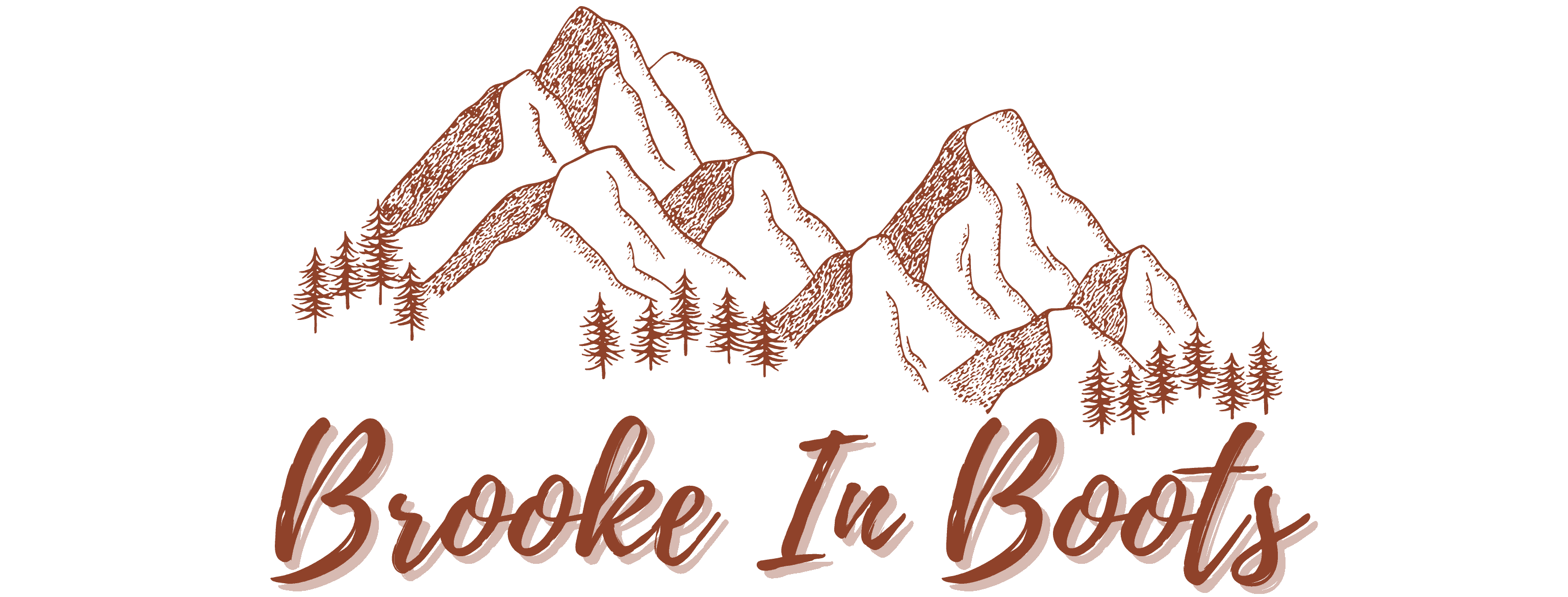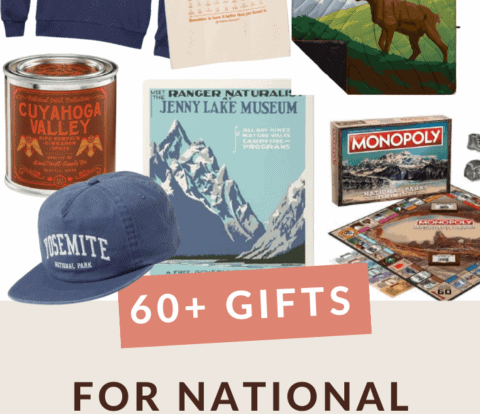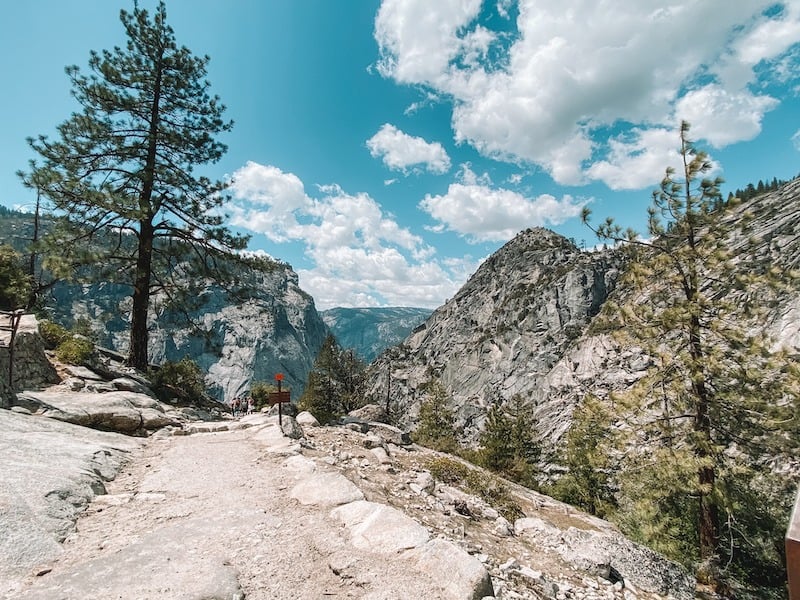
You never forget entering Yosemite National Park for the first time. This spectacular National Park located deep in the Sierra Nevada Mountains of California is one of the most beautiful National Parks in the United States.
There are five entrances to Yosemite National Park. Picking the best entrance to Yosemite depends on where you are coming from, road conditions, and where you are headed inside the Park.
Disclosure: This page may contain sponsored content or affiliate links, including Amazon links, where I earn a small commission from any purchase – at no extra cost to you. This commission helps keep Brooke In Boots up and running. As always, all opinions are 100% honest and my own!
I’ve visited Yosemite over a dozen times, and I’ve navigated Yosemite’s entrances in all conditions. In this guide, I’ll share more each entrance in more detail, the pros and cons of each entrance, as well as important driving and road condition information to help you choose the best entrance to Yosemite National Park
The five entrances to Yosemite National Park are:
- Big Oak Flat Entrance or West Entrance (Highway 120 from Groveland)
- El Portal Entrance or Arch Rock Entrance or Central Entrance (Highway 140)
- Wawona or South Entrance (Highway 41)
- Tioga Road or East Entrance (Highway 120 from Lee Vining)
- Hetch Hetchy Entrance
So, which entrance is best?
In general, if you are headed to Yosemite Valley, the best entrance from San Francisco , north and west of Yosemite, is the Big Oak Flat Entrance, the best entrance from Los Angeles, and south of Yosemite, is the Wawona Entrance, and the best entrance from Reno, Tahoe and points east is the Tioga Road entrance.
Important Tips for Getting to Yosemite
An important thing to remember is Yosemite is huge – about 748,000 acres, or about the size of the state of Rhode Island! Yosemite National Park is located in the Central Sierra Nevada Mountains of California. The Park is located about half-way up the state, on the eastern side, near the Nevada state border.
Yosemite is located just north of Sequoia and Kings Canyon National Parks, also within the Sierra Nevada mountains. It’s about 3.5 Hours from Sequoia-Kings to Yosemite Valley.
Most visitors will drive from the airport to Yosemite, and having a vehicle while visiting the Park is highly recommended.
Update for 2024: Yosemite National Park will require day-use and peak-hours reservations to enter Yosemite for dates in February & April – October 2024. Learn more about these new changes, here.
The closest major cities to Yosemite National Park are Merced, California (2 Hours), Fresno, California (2.5 Hours), and Sacramento, California (3.5 Hours).
The cities of San Francisco and San Jose, California are approximately 4.5 hours drive from Yosemite Valley. Los Angeles is approximately 7 hours from Yosemite.
There are multiple entrances to the Park, some are closed Winter to late-Spring, and one which is only open during daylight hours.
Unless otherwise noted, all distances and times in this article are to the Yosemite Valley Visitor Center.
Yosemite Valley is the heart of the National Park, and most visitors will spend some, or all, or their time there.
Confused? The good news is that all the entrances except the Hetch Hetchy entrance lead to Yosemite Valley.
Take this itinerary to go! The printable Yosemite Itinerary Guide has your perfect 1, 2, or 3 day Yosemite trip completely planned for you! With over 20 pages of detailed hiking guides, printable daily itineraries, lodging and dining suggestions and more, you can spend less time planning and more time making epic memories! Check it out, here.
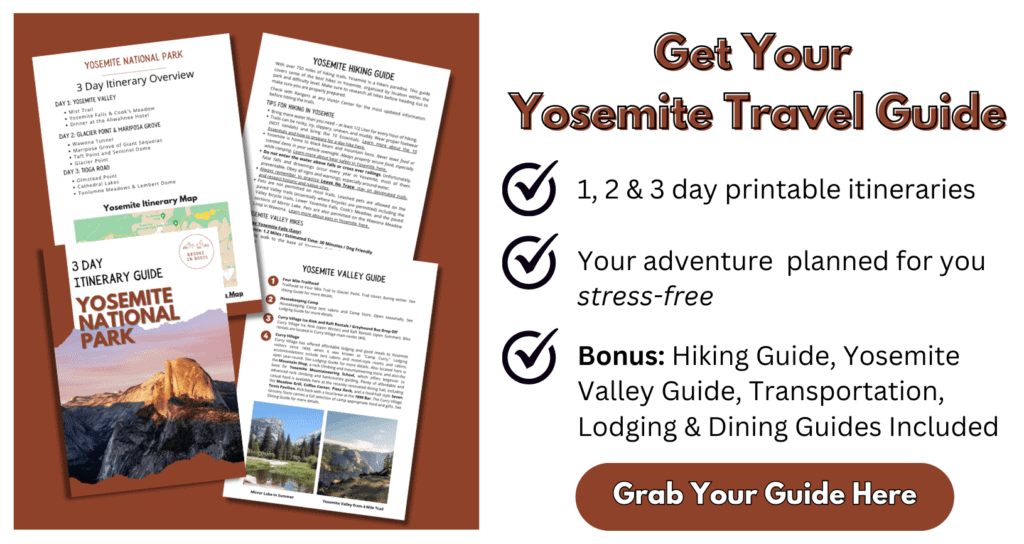
Map of the Entrances to Yosemite National Park
There are five vehicle entrances to Yosemite National Park. Which entrance you use will depend entirely on where you are coming from and where you are headed inside the Park.
To make matters more confusing, each entrance is referred to by several different names, even by NPS and Park staff.
The good news is that almost all roads (except Hetch Hetchy) eventually lead to Yosemite Valley, the hub of activity inside the Park. Use the map and directions below to plan your trip into Yosemite National Park.
Map of Yosemite National Park Entrances

Big Oak Flat Entrance or West Entrance (Highway 120 from Groveland)
The Big Oak Flat Entrance or West Entrance enters Yosemite National Park through Highway 120 from the town of Groveland, California.
When is this the best entrance to Yosemite? If you are driving from the Bay Area (San Francisco, Oakland,) or Sacramento, the Big Oak Flat Entrance is generally the best entrance to Yosemite National Park.
Maximum Vehicle Length: 45 Feet
Height Restrictions: 10’3″ tunnels from the Valley, 13’8″ from center.
Seasonal Restrictions: Open Year Round, weather permitting. Chains may be required during winter.

Driving to Yosemite via Big Oak Flat Entrance
From points West, head east on Highway 120. If you need to pick up groceries, the best place to stop before Yosemite when using the Big Oak Flat entrance is the small town of Oakdale.
Before entering the Park on Highway 120, you’ll encounter “New Priest Grade Road” a steeply graded road of switchbacks that ascend into the Sierra Foothills. The first time I used this entrance to Yosemite, I was a little intimidated driving this steep road before sunrise, but take your time and drive carefully.
RVs, trailers, and passenger vehicles are all fine on this road, just drive carefully.
Do not use Old Priest Grade Road – this apparent “shortcut” is SERIOUSLY steep old road (20% grade in some spots) a killer on the brakes, and downright impassible for RVs and trailers.
After entering the Park, you will descend into the Valley via Big Oak Flat Road. Your drive takes you through a number of tunnels (10’3″ height restriction from the Valley) before entering the magnificent Yosemite Valley.
Using the Big Oak Flat Entrance in Winter
While Highway 120 and the Big Oak Flat entrance is the most direct entrance for the Bay Area, I’ve found this is not the best entrance to Yosemite in winter.
As I mentioned, the road leading to the Big Oak Flat entrance is steep and climbs to higher elevations than the El Portal / Highway 140 Entrance. That means that this winding mountain road is more likely to have icy and snowy conditions during winter and spring,
To avoid icy conditions, you might want to use the El Portal / Highway 140 Entrance. The El Portal Entrance doesn’t gain or loose as much elevation as the other Park entrances, making it a relatively straightforward trip, and often less icy and treacherous in winter.
El Portal Entrance or Arch Rock Entrance or Central Entrance (Highway 140)
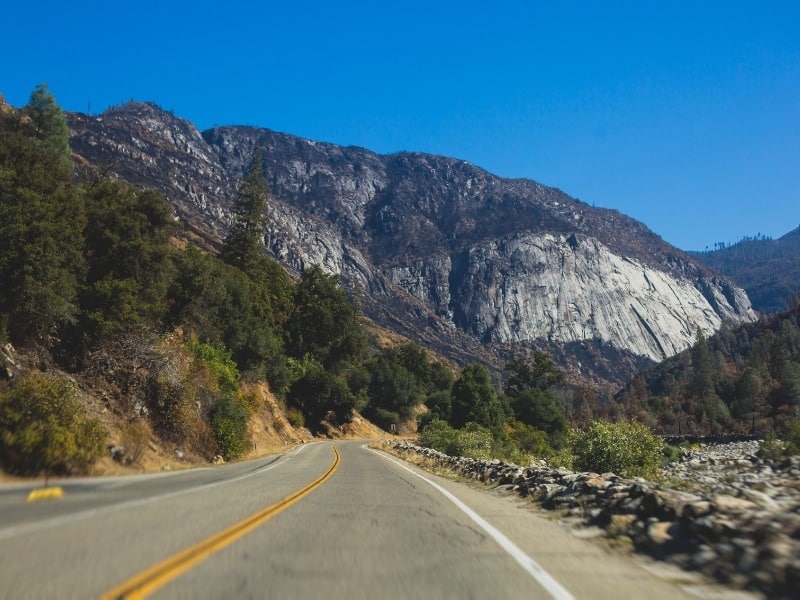
The El Portal Entrance (also labeled Arch Rock or Central Entrance on maps) enters Yosemite National Park on Highway 140, outside the town of El Portal.
When is this the best entrance to Yosemite? If you are driving from San Jose, California the El Portal Entrance is the most direct entrance to Yosemite.
Drivers from the Bay Area might also want to use El Portal Entrance as an alternative entrance. Highway 140 does not gain or loose as much elevation as the other Park entrances, making it a relatively straightforward trip, and often less icy and treacherous in winter.
Before entering the Park on Highway 140, you will pass through the town of Mariposa, approximately 1 Hour from Yosemite Valley. Mariposa is a small town with a grocery store, restaurants, and lodging and conveniently located for visitors not staying inside the Park.
Maximum Vehicle Length: 45 feet for single vehicle, 60 feet for combination vehicle, 35 feet for towed vehicle from hitch to rear bumper.
Height Restrictions: 10’2″ from the curb in Wawona Tunnel.
Seasonal Restrictions: Open Year Round, weather permitting. Chains may be required during winter.
Wawona or South Entrance (Highway 41)
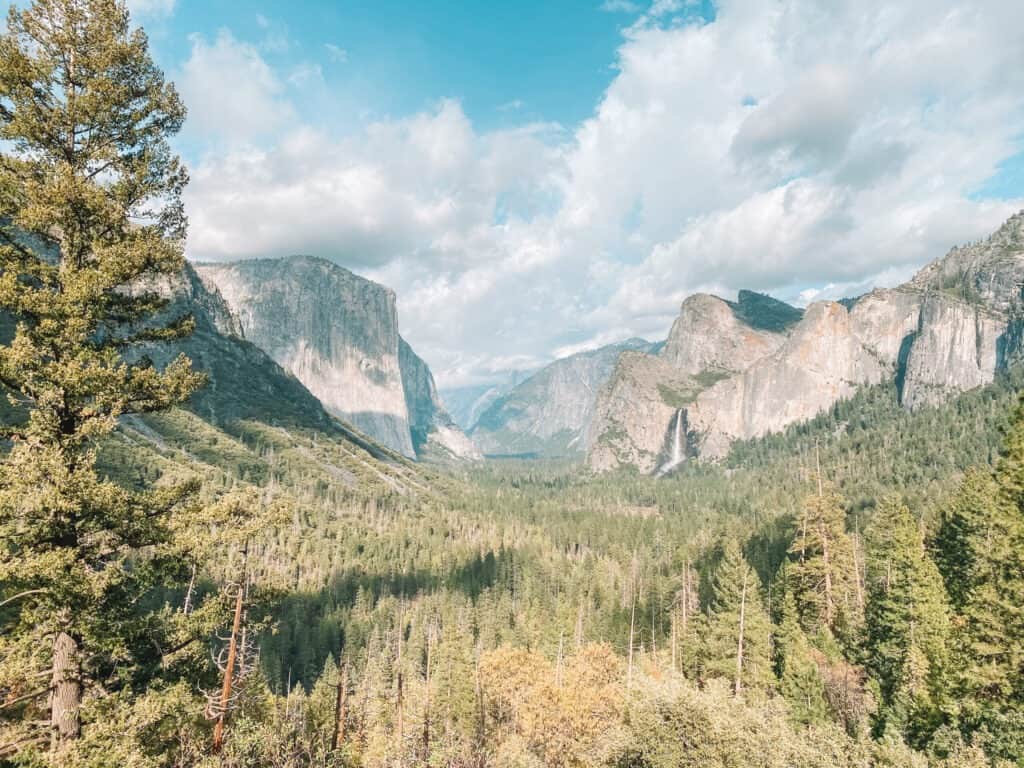
The Wawona Entrance (also called the South Entrance) enters Yosemite National Park from the south on Highway 41, through the towns of Oakhurst and Fish Camp.
When is this the best entrance to Yosemite? If you are driving into Yosemite from Fresno, Los Angeles, San Diego and all points south of the Park, the Wawona or South Entrance on Highway 41 is the best entrance to Yosemite National Park.
This is the best entrance for visitors staying at the historic Wawona Hotel inside the Park, the Redwoods in Yosemite cabins, Yosemite West cabin rentals, and Wawona campground. Near the Wawona entrance, drivers can easily head towards the Mariposa Grove, Glacier Point (seasonal), and Badger Pass Ski Area (seasonal).
Maximum Vehicle Length: 45 feet
Height Restrictions: 13″
Seasonal Restrictions: Open Year Round, weather permitting. Chains may be required during winter.
Entering Yosemite through Wawona Entrance
From Fresno, Highway 41 is a straightforward road into the Sierra foothills. The Highway gradually ascends into oak and scrub hills before climbing to over 6,000′ at the Wawona entrance.
From Wawona, you will descend over 1 hour into Yosemite Valley before arriving at quite possibly the most famous view in any National Park: The Wawona Tunnel. Even if you aren’t entering or exiting through Highway 41 – make sure to check out the Wawona Tunnel as part of your epic Yosemite Itinerary!
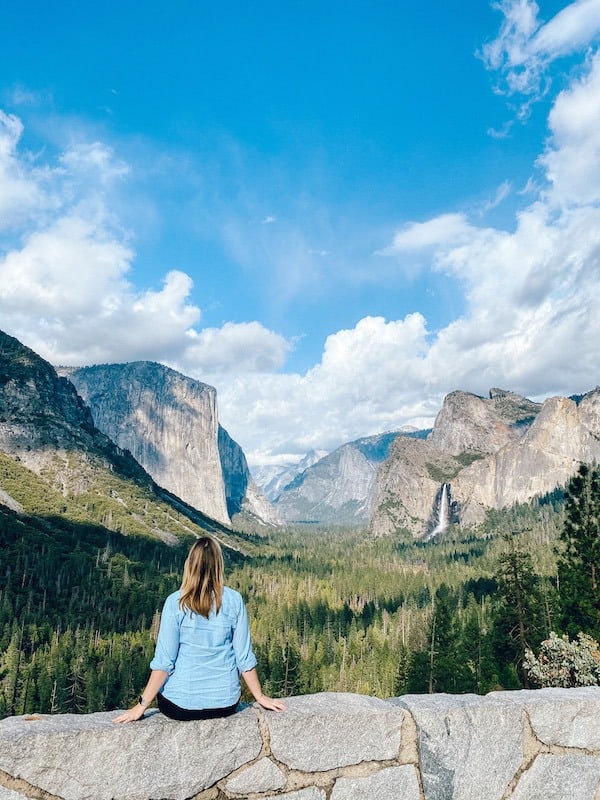
If you are heading to the Park from the South and want that “wow I can’t believe my eyes” moment when entering Yosemite Valley, the Wawona / South Entrance is my pick for the best entrance to Yosemite National Park.
Growing up in Southern California, this is the entrance to Yosemite that I used most frequently. And let me tell you, even after dozens of visits, this road takes my breath away every time!
Tioga Road or East Entrance (Highway 120 from Lee Vining)

There is only one entrance to Yosemite from the eastern side of the Sierra Range. The eastern entrance is Tioga Road (or East Entrance), a continuation of Highway 120 through the Park and into the town of Lee Vining on the rugged eastern Sierras.
When is this the best entrance to Yosemite? If you are driving to Yosemite from Reno, Lake Tahoe, Mammoth Lakes, Death Valley, Highway 395 or all points east of the Park, the best entrance is the Tioga Road or East Entrance to Yosemite National Park.
Maximum Vehicle Length: None. Learn more about driving a trailer on Tioga Road, here.
Height Restrictions: None
Seasonal Restrictions: Tioga Road is closed seasonally in the winter, usually from late-November to May (or later in high-snow years).
Entering Yosemite through Tioga Road
From Lee Vining, it is a short, but extremely steep, 20 minutes to the Park Entrance and over Tioga Pass, at nearly 10,000 feet in elevation.
Along the way, you’ll pass by Tuolumne Meadows, Tenaya Lake, Olmstead Point, and dozens of the most spectacular hiking trails in the world. Don’t forget to check out these spots as part of the perfect Yosemite itinerary, in this blog post!
It takes approximately 2 hours to drive from the Park’s East Entrance station to Yosemite Valley.
There are no height or trailer restrictions on Tioga Road, but vehicles towing trailers should take extra precautions when driving on the steep road, which at times is an 8% grade. Learn more about driving a trailer on Tioga Road, here.
If you are visiting Yosemite while Tioga Road is open, you absolutely should stop here! This entrance to Yosemite is one of the most scenic drives in any National Park. Learn more about visiting Tioga Road and Tuolumne Meadows and plan your ultimate Yosemite National Park Itinerary here.
Tioga Road and East Entrance Seasonal Closures
The Tioga Road entrance is the only entrance to Yosemite that completely closes during the winter season. Due to the high altitude, heavy snow, and avalanche danger, Tioga Road closes after the first significant snowfall of the season. This usually happens in late October to mid November.
Tioga road reopens once the arduous task of snow removal is complete, usually in May. This date can vary wildly, depending on the amount of snow accumulated in the Sierras. The snow accumulation is called the “snowpack.” The snowpack this is measured every year on April 1, and listed as a % of the historic average of 222 inches of snow (yup, that’s 18.5 feet of snow!).
In high snow years, Tioga road may not open until much later. In the historic winter of 2023, Tioga Road could not be cleared until almost August!
Recent Tioga Road Closing and Opening Dates
| Year | Opening Date (Spring) | Closing Date (Winter) | Snowpack % |
|---|---|---|---|
| 2023 | July 22 | TBD | 244% |
| 2022 | May 27 | October 31 | 41% |
| 2021 | May 27 | October 21 | 63% |
| 2019 *2020 Excluded due to COVID delays | July 1 | November 19 | 176% |
| 2018 | May 21 | November 20 | 67% |
Waiting for Tioga to reopen? Check the Tioga Road plow status, here, when snow removal begins every April.
Hetch Hetchy Entrance

If you are interested in visiting the Hetch Hetchy Reservoir area of Yosemite National Park, you will need to enter using the Hetch Hetchy Entrance. The Hetch Hetchy Entrance is located on Hetch Hetchy Road, off Highway 120 / Big Oak Flat Road. The turnoff for Hetch Hetchy is a short distance from the Highway 120 / Big Oak Flat entrance to Yosemite.
The Hetch Hetchy entrance is unique in that it is the only entrance that does not lead to Yosemite Valley. It is also the only entrance that is not open 24 hours a day.
When is this the best entrance to Yosemite? The Hetch Hetchy reservoir is only accessible from this entrance. You cannot get to Yosemite Valley, or any other areas of Yosemite from this entrance.
Maximum Vehicle Length: 25 feet
Height Restrictions: 8 feet (mirror to mirror); RVs take note: most RVs shorter than 25 feet are more than 8 feet wide and are NOT permitted on Hetch Hetchy Road.
Seasonal Restrictions: Hetch Hetchy road is open year-round, but may close due to ice and snow or be subject to chain restrictions.
Hetch Hetchy Entrance Hours
The Hetch Hetchy entrance is only open during daylight hours. There is no vehicle access to the Hetch Hetchy area when the road is closed.
The Hetch Hetchy Entrance is open during the following hours:
April 1 to April 30: 8 am to 7 pm
May 1 to Labor Day: 7 am to 9 pm
Day after Labor Day to October 31: 8 am to 7 pm
November 1 to March 31: 8 am to 5 pm
What is Hetch Hetchy?
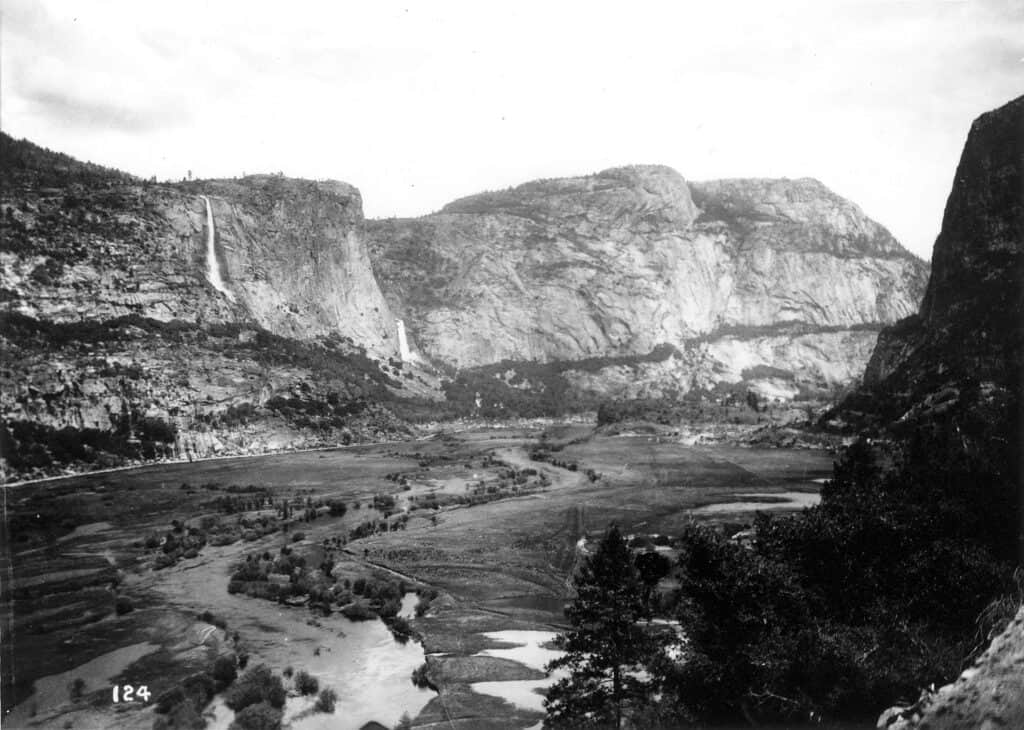
Did you know there is a valley in Yosemite, filled with some of the tallest waterfalls in North America and soaring granite cliffs? No I’m not talking about Yosemite Valley, its Hetch Hetchy Valley.
Before 1923, Hetch Hetchy Valley was said to rival Yosemite Valley for its magnificent beauty. But in the early 1900s, as the population of San Francisco and the Bay Area exploded, the city, state and US governments went looking for a stable water supply. To supply water, the Tuolumne River would be dammed and the Hetch Hetchy Valley turned into a massive reservoir.
After much controversy, in 1923, the O’Shaughnessy Dam was completed and the valley filled with water. To this day, the Bay Area continues to draw from the Hetch Hetchy reservoir, and the Valley submerged under hundreds of feet of water.
Dam Hetch Hetchy! As well dam for water-tanks the people’s cathedrals and churches, for no holier temple has ever been consecrated by the heart of man.
John Muir, Naturalist
The federal government, state of California, and city of San Francisco all still opposed the decommissioning of the damn. Groups like Restore Hetch Hetchy continue to work to bring back and preserve this magnificent piece of wilderness for the benefit and enjoyment of all people.
Getting from Yosemite Valley to Hetch Hetchy
Hetch Hetchy is located 38 miles from Yosemite Valley. It takes about 1 Hour and 15 minutes to drive from the Valley to Hetch Hetchy. There is no public transportation to Hetchy Hetchy, so you’ll need to bring your own vehicle.
To travel between Yosemite Valley (and other areas inside Yosemite) and Hetch Hetchy, you will need to exit the Park via the Big Oak Flat Entrance (Highway 120). On Big Oak Flat Road, turn right on Evergreen Road. In the (very) small town of Mather, turn right onto Hetch Hetchy Road, and follow to the entrance station.
Take this itinerary to go! The printable Yosemite Itinerary Guide has your perfect 1, 2, or 3 day Yosemite trip completely planned for you! With over 20 pages of detailed hiking guides, printable daily itineraries, lodging and dining suggestions and more, you can spend less time planning and more time making epic memories! Check it out, here.

Tips for Driving to Yosemite National Park
Update for 2024: Yosemite National Park will require day-use and peak-hours reservations to enter Yosemite for dates in February & April – October 2024. Learn more about these new changes, here.
Most visitors drive to Yosemite in their own car or a rental vehicle. Apart from traffic and winter conditions, driving to Yosemite is a relatively straightforward and beautiful experience.
As drivers ascend from the foothills into the high Sierra mountains, expect winding mountain roads and steep drop offs. The roads are well maintained in and near the Park. Make sure to follow all traffic signs and posted speed limits.
Do NOT rely on cell service for driving directions to Yosemite. Cell service is unreliable and nonexistent in most areas of the park. Always print or write out your Yosemite itinerary or download it to your phone before leaving.
When planning your drive to Yosemite, double check that your directions are taking you to your specific destination within the Park. Yosemite is massive, with multiple entrance stations. Just typing in just “Yosemite” to your GPS or map app will NOT get you where you want to go!
When visiting during peak months of late Spring to early Fall, expect long wait times at entrance stations, and full parking lots. The key to a stress-free (or at least less-stress) Yosemite itinerary is to exercise patience and kindness, especially during peak hours.
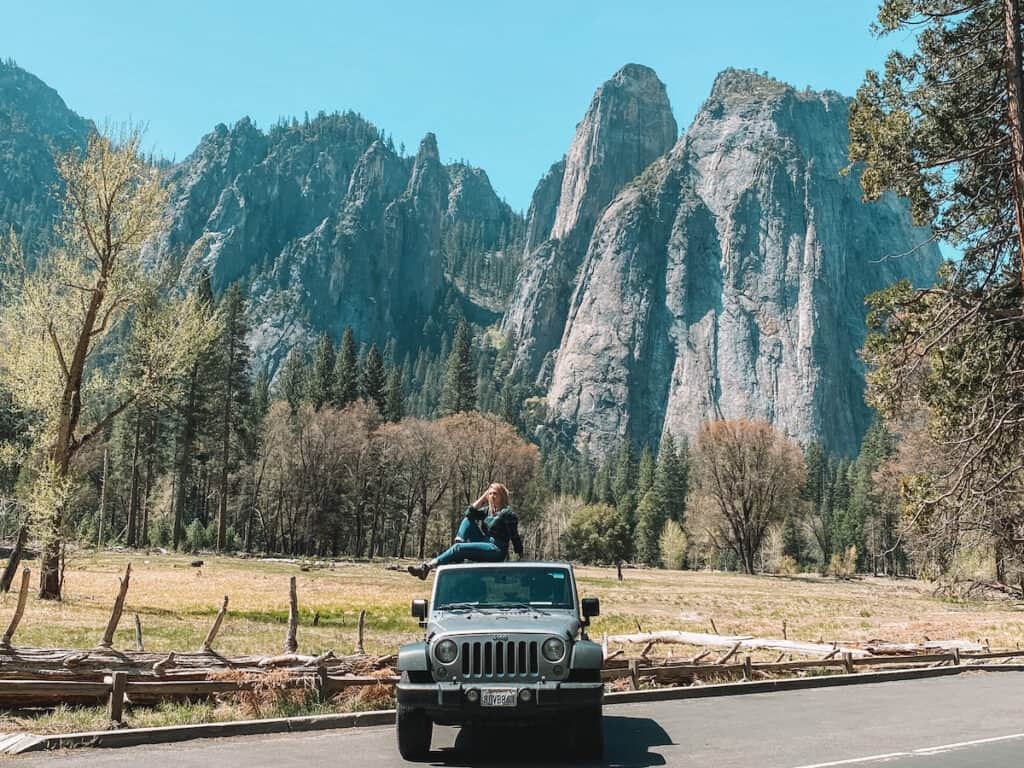
Taking Public Transportation to Yosemite National Park
Unlike many National Parks, public transportation IS AVAILABLE to Yosemite Valley. Daily bus service is provided by Yosemite Area Rapid Transit (YARTS) year-round.
YARTS operates 4 routes to Yosemite Valley and gateway communities and hotels. The routes depart from Merced (including the Merced Regional Airport, Geyhound, and Amtrak Station), Fresno (including Fresno-Yosemite Airport and Amtrak/Greyhound Station), Mammoth Lakes / Highway 395, and Senora.
Reservations are strongly recommended for YARTS buses. However, visitors arriving via YARTS do NOT need an additional peak-hours or day-use reservation to enter the park (when required).
Only the Merced / Highway 140 Route operates year-round, and services are reduced during winter and holidays. Learn more about the YARTS bus and make reservations, here.
Want to learn more about planning an epic National Parks trip? Grab my free Ultimate National Parks Planning Guide, including 70+ pages of National Park packing checklists, planning tips, and everything you need to know to start planning a trip to all 63 National Parks!
Driving & Parking In Yosemite National Park
Parking in Yosemite Valley
Getting around Yosemite Valley is easy thanks to the excellent Shuttle system. Once you arrive in Yosemite National Park, park your vehicle at your hotel or campground if you are staying overnight.
Guests of the hotels and campgrounds will be provided with a dashboard pass to park at these locations. Makes sure to display your parking pass at all times! If you do not have a pass, do not park at these locations.
If you are staying outside the Valley, park in one of the designated day-use parking lots. Use the map below to find Day-Use Parking in the Valley. Most visitors will want to park at the Visitor Center and Village Parking. The excellent Yosemite Valley Shuttle will pick you up there and take you to all major sights in the Valley – for free! Learn more about using the Yosemite Valley Shuttle, below.
Parking Lots fill to capacity early during late Spring to early Fall, especially on weekends and holidays. Plan to arrive well before 9AM for day-use parking lots.
Bear Safety and Your Vehicle in Yosemite National Park: Yosemite is home to hundreds of black bears. While most visitors never see a bear, it is important (and legally required) to take proper precautions, especially when it comes to food storage.
During the Day, store your food out of sight inside your vehicle, with the windows rolled up. At night, DO NOT leave any food or scented items in your vehicle. Bring them into your hotel or use a bear-proof food storage locker. Lockers are available at every campsite, Curry Village, and Housekeeping.
Remember, “food” means any scented items, including lotions, sunscreen, trash, and empty coolers.
Violating these rules can get you a hefty fine, your vehicle impounded, or your car totally destroyed by a curious bear. Bears who routinely break into vehicles or begin associating humans with tasty food have to be euthanized. By safely storing your food, you are protecting yourself AND the lives of these beautiful animals.
Driving to Glacier Point
Glacier Point is quite simply one of the most stunning views in Yosemite, and a must on any Yosemite itinerary (weather permitting). Parking is available along Glacier Point Road and at Glacier Point.
It takes approximately 1 hour to drive from Yosemite Valley to Glacier Point.
There is no free shuttle between Yosemite Valley and Glacier Point. However, the Glacier Point guided bus tour is a 4 hour guided tour from the Valley Floor, up 3,200 feet to stunning Glacier Point. Purchase a round trip ticket for $57, or a one-way ticket for $28 and hike down to the Valley via the Four Mile Trail (STRENUOUS), or vice-versa.
Shuttles and Tour Buses Inside Yosemite National Park
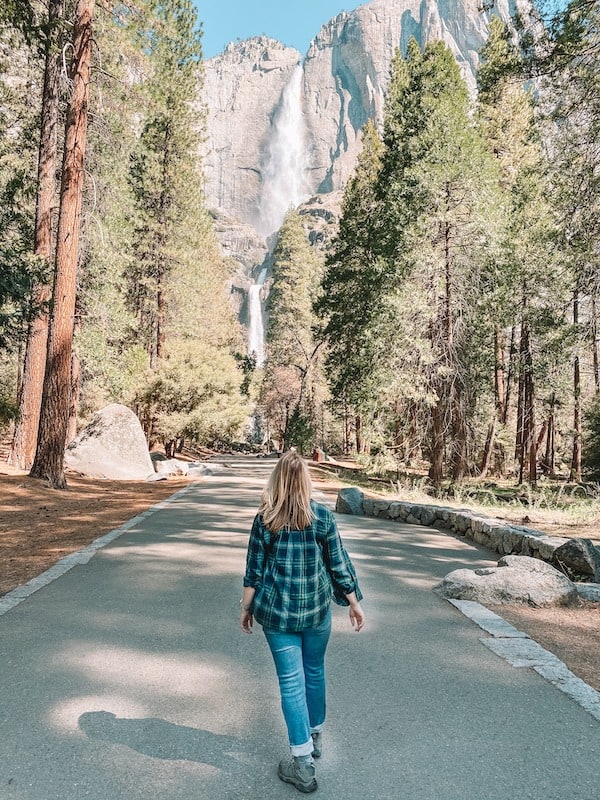
Yosemite Valley Shuttle
The Yosemite Valley Shuttle is one of the most convenient and easy-to-use shuttles in the entire National Park system. Its also free. Park your car at your lodging, campground or day-use parking lot and walk to the nearest shuttle stop (never far in the Valley).
Two shuttle lines run in Yosemite Valley: the East Valley Shuttle; and the Valleywide Shuttle. Shuttles are free to use, run between 7am and 10pm, and arrive every 8 to 22 minutes.
Most major sights and trailheads within Yosemite Valley are within a short walk of a shuttle stop.
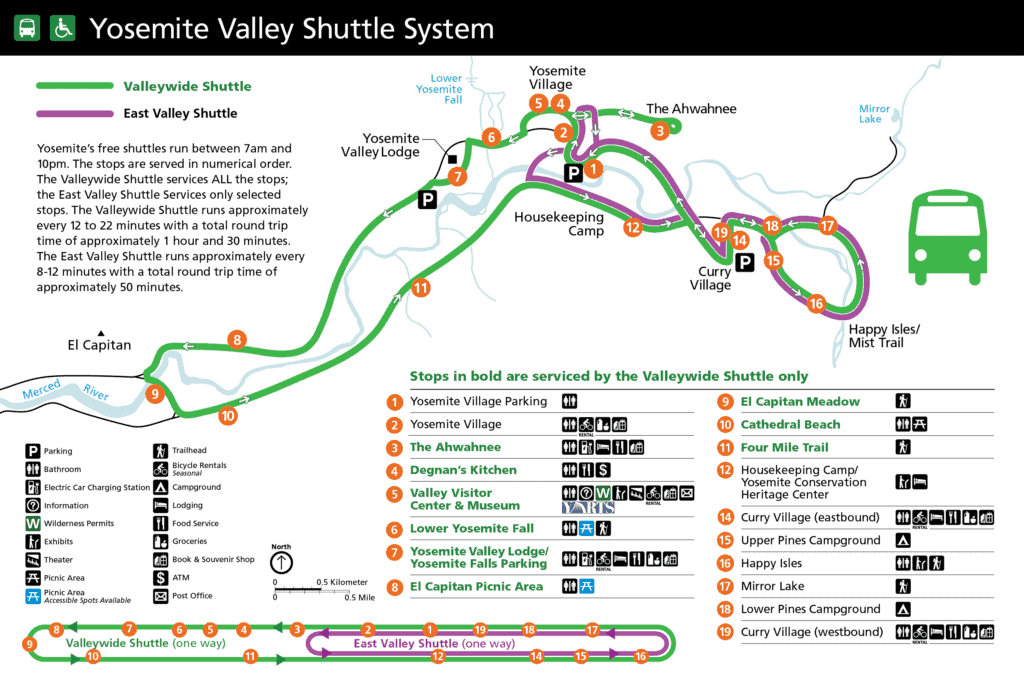
Glacier Point Guided Bus Tour
There is no free shuttle between Yosemite Valley and Glacier Point. However, the Glacier Point guided bus tour is a 4 hour guided tour from the Valley Floor, up 3,200 feet to stunning Glacier Point.
Purchase a round trip ticket for $57, or a one-way ticket for $28 and hike down to the Valley via the Four Mile Trail (STRENUOUS), or vice-versa.
Tuolumne Meadows Shuttle and Hiker Bus
Parking along the Tioga Road corridor is limited and often frustrating. The Tuolumne Meadows Shuttle ($) provides service between Tuolumne Meadows Lodge and Olmstead Point, from mid-June to mid-September. Park your car at the Lodge and take the shuttle to various trails and sights along Tioga Road.
Learn more about the Tuolumne Meadows Shuttle, here.
If you want to avoid driving the 3+ hours round trip drive between Yosemite Valley and Tuolumne Meadows, consider booking a seat on the Hiker Bus. The Hiker Bus offers shuttle service between Yosemite Valley and various trailheads along Tioga Road. Learn more about the Hiker Shuttle, here.
Mariposa Grove Shuttle
Yosemite’s Mariposa Grove of Giant Sequoias, is home to over 500 Giant Sequoia trees. These massive trees are the largest living organisms on earth. Walk amongst these silent giants through a network of newly renovated trails and boardwalks.
When Mariposa Grove Road is open (generally April – December, weather permitting) visitors are required to park at the Mariposa Grove Welcome Center. From the Welcome Center, visitors can take the free shuttle 2 miles to the Grove. When Shuttle Service is running, only visitors with disability placards may park directly at the Grove.
Learn more about the Mariposa Grove Shuttle and accessing the Grove of Giant Sequoias, here.
Explore More National Parks
Get the Ultimate National Parks Planning Guide (for free!) sent to your inbox, full of important planning information, printable packing lists, and the best things to do in all 63 National Parks.
Big Bend: Epic Big Bend Itinerary Guide
Bryce Canyon: One Epic Day in Bryce Canyon National Park
Cuyahoga Valley: 17 Best Things to Do in Cuyahoga Valley National Park
Great Smoky Mountains: The Ultimate Great Smoky Mountains Itinerary in 2 Days
Joshua Tree: The Perfect Day Trip to Joshua Tree National Park
New River Gorge: The Best Hikes in New River Gorge National Park
Yosemite: Epic Yosemite 2 Day Itinerary – How to Spend 2 Perfect Days in Yosemite
